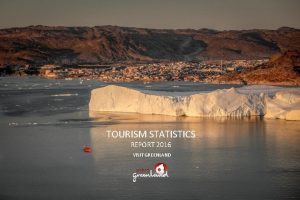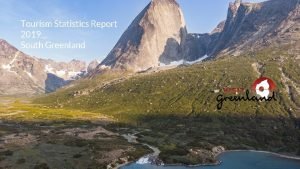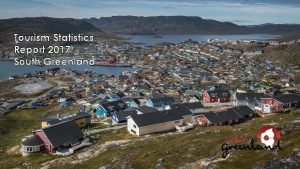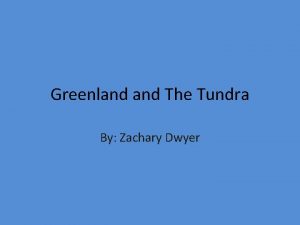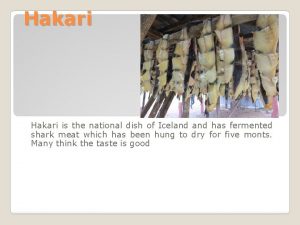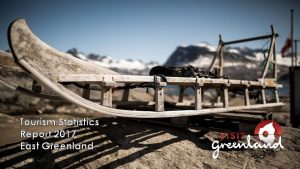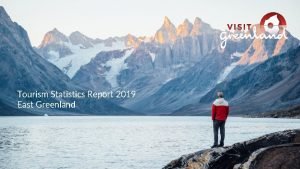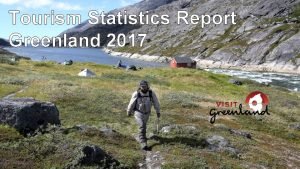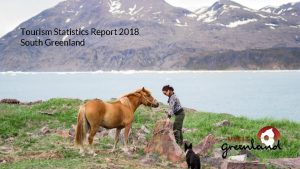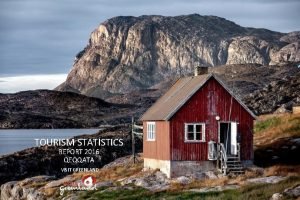Tourism Statistics Report 2017 East Greenland Introduction As









- Slides: 9

Tourism Statistics Report 2017 East Greenland

Introduction As explained in the national tourism statistics report 2017 the flight passenger data from 2017 unfortunately cannot be used to identify trends in the Greenlandic tourism development as it is not complete. Visit Greenland, Statistics Greenland Mittarfeqarfiit have joined forces to ensure a more complete registration in 2018. Thus this regional report primarily focuses on the overnight stay statistics and the cruise statistics. We recommend that this report is seen as a supplement to the national report as that is based on a larger data volume minimizing the statistical uncertainty. Furthermore the national report looks in depth at the latest tourism interviews conducted by two Visit Greenland interns from the tourism program at Aalborg University during July and August 2017. Should on with a cautious eye judge the 2017 tourism season in East Greenland data – that does not paint an entirely clear picture – shows a small growth compared to 2016. The tourist overnight stay statistics, the cruise statistics as well as feedback from Greenlandic tourism operators show that overall 2017 was a good year for tourism in Greenland. As the incomplete flight passenger data from this year could not be used we chose instead to ask 240 Greenlandic tourism operators about their 2017 season and their expectations for 2018. We received answers from a total of 82. The numbers on overnight stays show an overall growth of approximately 10% while the number of cruise passengers has increased by 13. 1%. Only 5. 5% of the tourism operators reported negative growth while the rest either had a season similar to 2016 or experienced growth. Globally 2017 has been one of the best years in recent times with a total growth of 7% with Europe as a region experienced a growth of 8%. The prognosis on the coming years points to a continued medium-high global growth of approximately 5%. Iceland is still a part of the growth elite and in 2017 the country experienced a growth in the number of international passengers of 24. 2%. It is expected that during 2018 more than 10 million passengers will pass through Keflavik. Despite the fact that Air Iceland Connect report a negative growth of -9. 7% on routes between Iceland Greenland from 2016 to 2017 the potential for Iceland-Greenland combination trips is still relevant to consider also by virtue of the feedback from many of the 292 land based tourists interviewed by Visit Greenland in July-August (please, see the national tourism report p. 28). Each region undeniably still has its challenges whether it’d be accessibility, over- or under-capacity in the high season, logistics and the like. However since 2014 there has been a relatively nice growth nationally and overall there is reason for continued optimism when it comes to the next few years.

Flight Passengers Travelling Out of Greenland via the 2 Airports in the Region As mentioned in the introduction that registration of the country of residence of the passengers in the course of 2017. With 37% non-registered Kulusuk Airport is especially affected. Nerlerit Inaat had 15. 6% non-registered. As mentioned initiatives to ensure a far more complete registration in 2018 has been launched. All country segments have less than 1, 000 passengers and the growth rates are thus listed in grey, as a difference of even a few passengers from year to year will cause an exaggerated fluctuation in the growth rate and must therefore be taken with reservations. Every year the group of non-registered is distributed on all countries of residence as well as Other Europe and Other countries relative to the share of each in the pool of registered. This method is agreed upon with Statistics Greenland in order for the numbers to be more representative. The 2017 flight passenger data is too incomplete to be representative, so this year, much more attention is paid to the statistics on overnight stay s.

Number of Overnight Stays in the Region A growth of 106. 8% in the number of international overnight stays (per definition tourists) is a very significant growth. Included in the number below are registrations from 3 medium size accommodations in the region that only began to submit registrations in 2017. If one is to make a real comparison with 2016 where the 3 accommodations did not submit their numbers must be deducted from 2017. That equals 10, 587 tourist overnight stays instead of 15, 675 which is the equivalent of 39. 7% which sounds more plausible, though still surprisingly high. The segment Other countries represent the largest growth with 8, 478 overnight stays corresponding to a growth of 483. 1%. Here the data from the above mentioned 3 ‘new’ accommodations have not been deducted, as is also the case with all other country segments mentioned below. With 1, 037 more overnight stays Germany is in 2. Place, the equivalent of a growth of 87. 8%. There has been a decline of -60. 5% of Greenlandic citizens. Slightly surprising tourists residing in Italy come in 4. Place with a growth of 914. 5%, the equivalent of 759 overnight stays. We are, however, dealing with segments with less than 1, 000 overnight stays, so growth rates must be taken with reservations aide from the fact that these data include the ‘new’ accommodations. It is still a remarkable growth though. With all the necessary reservations it does not make sense to draw any conclusions based on the numbers from the rest of the country segments. There are still accommodations in the region that do not submit registrations. Statistics Greenland VG are working on including them in the registration.

Number of Individual Guests in the Region In order to make a real comparison between 2016 and 2017 we must deduct data from the 3 recently added accommodations in the statistics database. The new accommodations represent 1, 015 international guests (per definition tourists). When they are deducted there was a growth in the number of international guests of 2. 9% which is significantly lower than the growth in the number of tourist overnight stays which is 39. 7% (please see the previous page). If these data are representative it means that each guest on average bought more overnight stays than what was the case in 2016. This trend can be seen in the data on the average number of overnight stays bought per guest that shows that for the tourist segment this number was 2. 7 in 2016 and 3. 4 in 2017. As for the average number of overnight stays per guest over a longer period of time, there are to years where 2 segments that stand out: In 2016 the number for the segment Canada is 7. 2. In 2017 the number for the segment Germany is 6, 9. Whether this is due to large groups from the two countries have visited in the year in question or if it is just a coincidence we do not know.

Occupancy Rate in Accommodations in the Region When one examines the pattern of the occupancy rate over the course of the 12 months of the year, the typical shape is that of a pyramid, thus the winter months have a low occupancy rate that then reach towards a peak in the summer and then culminate in July. The same trend is true for East Greenland. However, there is a tendency for the winter high season in April to present a small peak after which the curve typically drops slightly again in May. East Greenland is one of the best places to execute winter activities such as dogsledding and different kinds of skiing, so it makes perfect sense. The graph shows data on the period 2007 -2017 with 2016 and 2017 highlighted. The months of June was especially good in 2016 whereas the course of 2017 looks quite average. In order to have sustainable tourism it is optimal if one can keep up a certain level of activity and thus occupancy throughout all the months of the year. This has always been of the great challenges of the Greenlandic tourism industry as tourists most often go for either the winter or the summer experiences. There will probably always be the most activity in the summer high season, but at least objectively the shoulder seasons represent a potential – perhaps in particular via special product packages and or offers.

Number of Cruise Passengers in the Region 2017 vs 2016 The graph to the left: The growth of 11. 3% in the number of passengers on ships that visited Tasiilaq in 2017 is the equivalent of 447 extra passengers compared with 2016. The negative growth of -13. 9% in the number of passengers on ships that visited Ittoqqortoormiit in 2017 is equivalent of 267 fewer passengers compared with 2016. For the region in total there was a growth of 3. 1% equivalent of 180 extra passengers compared to 2016 which is satisfactory. In total Greenland had a 13. 1% growth which points to an increased demand for Greenland overall. The 6 largest cruise destinations in Greenland measured by the number of passengers on ships that called on the cities in question in the course of 2017 can be seen in the graph to the right. Despite that Tasiilaq is a small city by Greenlandic standards it is a relatively popular destination which is partly contributed to the close proximity to Iceland. The call list on cruise. visitgreenland. com/call-list shows that the large majority of ships to call on Tasiilaq have set sail from a port in Iceland. If you sell souvenirs/arts and crafts and want to make it easy for your guests to pay, one can rent a small mobile credit card terminal from nets. dk for circa 350 DKK/month and circa 115 DKK/month in a fixed fee for international card transactions. Please write lumholt@visitgreenland. com for more info.

Number of Port Calls in the Region According to Passenger Capacity 2015 -2017 The graph to the left: When one examines the number of port calls for ships in the region according to the 4 pax (passenger capacity) categories 0 -250, 251 -500, 501 -1200 and 1200+ pax it is clear that the biggest fluctuations from year to year can be found in the two smallest pax categories. • For the 0 -250 pax category there is a fall from 20 port calls in 2015 to 9 port calls in 2017 • For the second smallest category 251 -500 pax the 3 -year period has seen a gradual growth in the number of port calls from 3 to 7 • For the second largest category 501 -1200 pax the number of port calls in the period is stabile except from a decline from 3 port calls in 2016 to 2 port calls in 2017 • In the largest category 1200+ pax there has not been any port calls The graph to the right: When one examines the number of cruises in all of Greenland over a longer period of time it is clear that the largest fluctuations can be found in the smallest pax category. Number of port calls and number of cruises are not the same, as each cruise will have a number of port calls (typically between 3 and 6) before the passengers are exchanged. Unfortunately, we do not have cohesive data sets over a longer period of time on either number of port calls or number of cruises in Kujalleq, as the registration and the type of data collected changed from 2015.

Final Thoughts The flight passenger data show a negative growth within the tourist segment, all the while there is a growth in the number of tourist overnight stays (corrected for ‘new’ accommodations) of a staggering 39. 7% which is so high that one must suspect a certain amount of errors in the registrations. However, as mentioned previously we have chosen to ignore the 2017 flight passenger statistics due to the incomplete registrations. The number of individual guests/tourists in the accommodations shows a growth (corrected for ‘new’ accommodations) of 2. 9% which seems more likely than the very large growth in the number of tourist overnight stays. The growth of 3. 1% in the number of cruise passengers who visited the region in 2017 is positive, despite a negative growth Ittoqqortoormiit. Historic data shows that there is often a certain fluctuation from year to year in the number of passengers as well as cruises, so in that respect the result is close to status quo. For next year’s tourism statistics report we will focus even more on interviewing relevant operators in the Greenlandic tourism business as it will be a nice supplement to the data from Statistics Greenland. In November Visit Greenland will host the tourism workshop Towards More Tourism in Nuuk, and we hope to see as many tourism operators there as possible, and look forward to a mutually beneficial cooperation. Finally we wish you all a successful 2018 tourism season! Best regards Visit Greenland Compiled by Market Analysis Consultant Mads Lumholt, April 2018
